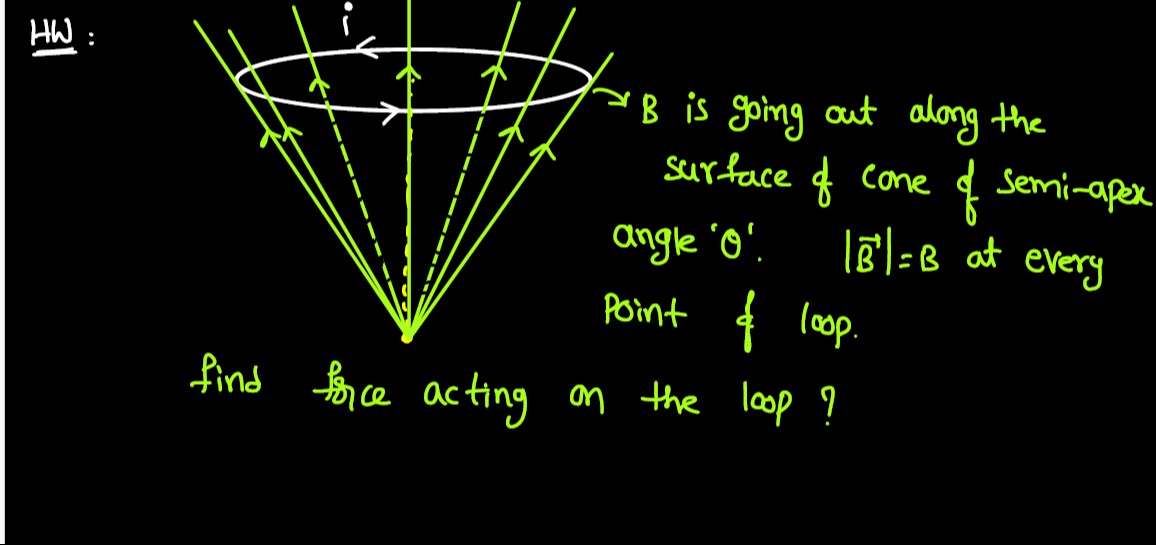Question
Question: B is going out along the surface of cone of semi-apex angle '$\theta$'. $|\overrightarrow{B}|$ = B a...
B is going out along the surface of cone of semi-apex angle 'θ'. ∣B∣ = B at every point of loop. find force acting on the loop?

The force is zero due to symmetry.
2πIrBcosθ along the axis of the cone.
2πIrBsinθ along the axis of the cone.
2πIrB perpendicular to the axis of the cone.
The force acting on the loop is 2πIrBsinθ directed along the axis of the cone, away from the apex.
Solution
The force on a current-carrying loop in a magnetic field is given by \vec{F} = \oint I d\vec{l} \times \vec{B}}. The magnetic field B is along the surface of the cone, pointing radially outwards from the apex. The magnitude of B is B and the semi-apex angle of the cone is θ. The loop is a circle of radius r lying on the surface of the cone, perpendicular to the cone's axis. The current i flows in a circular direction around the loop.
We can decompose the magnetic field B into two components:
- A component perpendicular to the plane of the loop: B⊥. This component is along the axis of the cone. Since the slant height makes an angle θ with the axis, B⊥=Bcosθk^ (assuming the loop is in the xy-plane and the cone axis is along the z-axis).
- A component parallel to the plane of the loop: B∥. This component lies in the radial direction within the plane of the loop. Its magnitude is Bsinθ, so B∥=Bsinθr^, where r^ is the radial unit vector in the plane of the loop.
The force on the loop is F=∮Idl×(B⊥+B∥)=∮Idl×B⊥+∮Idl×B∥.
The first term, ∮Idl×B⊥: dl is tangential to the loop. B⊥ is along the z-axis. The cross product dl×k^ results in a radial vector in the xy-plane. When integrated over the entire circular loop, the net force due to this component is zero due to symmetry. Alternatively, integrating dl×k^ over the loop gives zero.
The second term, ∮Idl×B∥: dl is tangential to the loop, and B∥ is radial in the plane of the loop. Let the loop be in the xy-plane. dl=rdϕϕ^ (where ϕ^ is the tangential unit vector) and B∥=Bsinθr^. The cross product dl×B∥=(rdϕϕ^)×(Bsinθr^)=rBsinθdϕ(ϕ^×r^). The cross product ϕ^×r^ is the unit vector perpendicular to the plane of the loop, which is k^ (if the current is counter-clockwise as shown in the figure). So, dl×B∥=rBsinθdϕk^. Integrating over the loop (from ϕ=0 to 2π): F∥=∮Idl×B∥=∫02πI(rBsinθdϕk^)=IrBsinθk^∫02πdϕ=IrBsinθ(2π)k^. The total force is F=F⊥+F∥=0+2πIrBsinθk^.
The force is directed upwards, along the axis of the cone. The magnitude of the force is 2πIrBsinθ.
The force acting on the loop is 2πIrBsinθ directed along the axis of the cone, away from the apex.
